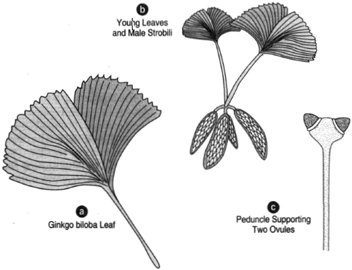Ginkgo biloba
 |
| Figure 27-7 (a) A Ginkgo biloba leaf. (b) Young leaves and catkinlike male strobili. (c) A peduncle supporting two young ovules. |
Gymnosperms are generally and correctly considered to be coniferous trees having needle-shaped leaves commonly retained on the plant for several years. They are thus called evergreens. An exception is Ginkgo biloba, which has many traits of a hardwood angiosperm. Ginkgo biloba is the only remaining survivor of the Ginkgophytes, which were extensive in the late Paleozoic period. Their ancestors are unknown, but they seem to have arisen from more than a single precursor. In past times, there were sixteen genera; now there is only one. The tree is commonly grown in cultivation, and probably does not grow in its native habitat. It is dioecious, and the staminate trees are preferred in cultivation because the “female” trees produce foul-smelling “fruits.” Leaves appear in late spring and are shed in the fall. Ginkgo biloba is commonly called the maidenhair tree because of the resemblance of its leaves to the maidenhair fern, Adiantum.
Two types of branches are noted: long-shoot branches and short-shoot branches. Long shoots form the main branches of the tree, and short shoots, which form on the main branches, bear clusters of leaves at their tips.
The male strobili of microsporophylls hang down, giving the appearance of catkins (a kind of inflorescence); the female structure develops pairs of ovules on short spur shoots. When the pollen grains come in contact with the nucellus, a passageway is digested through the nucellus and discharges sperm into the archegonial chamber. Although the sperm cells do not swim to the egg cell, their flagellated structure is evidence of their primitive ancestry.




